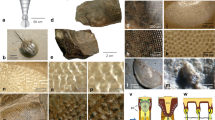Summary
Urastoma cyprinae (Graff) is a microturbellarian which has been recorded both as a free-living organism by Westblad (1955) and Marcus (1951) and as a commensal in various lamellibranch molluscs (see Burt & Drinnan 1968). The material used in this study came from oysters, Crassostroea virginica, collected off the coast of Prince Edward Island, in which hosts it occurs in large numbers especially during the summer months when the oysters are spawning (Fleming et al. 1981). When U. cyprinae is exposed to light as happens, for example, when an oyster is opened, it shows a marked negative phototactic response.
Preliminary work on the fine structure of the photoreceptors in U. cyprinae shows that the two eyes each consists of: (1) a single cup cell full of relatively large, electron-dense pigment granules; (2) a tripartite conical lens system; and (3) what appear to be two photosensitive rhabdomes. The pigment cup cell has a single, well defined nucleus situated basally and close to the membrane of the pigment cell furthest away from the rhabdomeres. The lens system consists of a cone made up of three, separate but equal, parts. Each part has two, flat inner surfaces which join at an angle of 120°, an outer rounded surface, and a rounded upper surface. When these three parts fit together, the cone-shaped lens is formed with the apex of the lens within the ‘cup’ of the pigment cell and the rounded, convex, broad end of the cone lying more or less at the same level as the top of the pigment cup and below the epidermis layer. The rhabdomeres lie between the electron dense lenses and the inside of the pigment cup. They show connections to the visual cells which are bipolar: one extension joining the rhabdomeres; the other constituting the axon which extends into the centrally situated brain or into the longitudinal, lateral nerves. The axons that enter the brain, form connections with other axons from the other eye. The axons that extend posteriorly in a lateral position, presumably play a role in facilitating the avoidance reaction.
The chemical nature of the unusual lens has not yet been determined. This is presently under investigation and will be reported later at which time our work will be discussed in relation to other types of rhabdomeric eyes in the Turbellaria.
Similar content being viewed by others
References
Burt, M. D. B. & Drinnan, R. E., 1968. A microturbellarian found in oysters off the coast of Prince Edward Island. J. Fish. Res. Bd. Can. 25: 2521–2522.
Fleming, L. C., Burt, M. D. B. & Bacon, G. B., 1981. Some Commensal Turbellaria of the Canadian East Coast. In: Schockaert, E. R. & Ball, I. R. (Eds.). Turbellaria. Proc. Third Int. Symp. Hydrobiologia. This volume.
Marcus, E., 1951. Turbellaria brasileiros (9). Bolm. Fac. Filos. Cienc. Univ. Sao Paulo. (Zool.) 16: 5–215.
Westblad, E., 1955. Marine ‘Alloeocoels’ (Turbellaria) from North Atlantic and Mediterranean coasts. I. Ark. Zool. 7: 491–526.
Author information
Authors and Affiliations
Rights and permissions
About this article
Cite this article
Burt, M.D.B., Bance, G.N. Ultrastructure of the eye of Urastoma cyprinae (Turbellaria, Alloeocoela). Hydrobiologia 84, 276 (1981). https://doi.org/10.1007/BF00026190
Issue Date:
DOI: https://doi.org/10.1007/BF00026190




